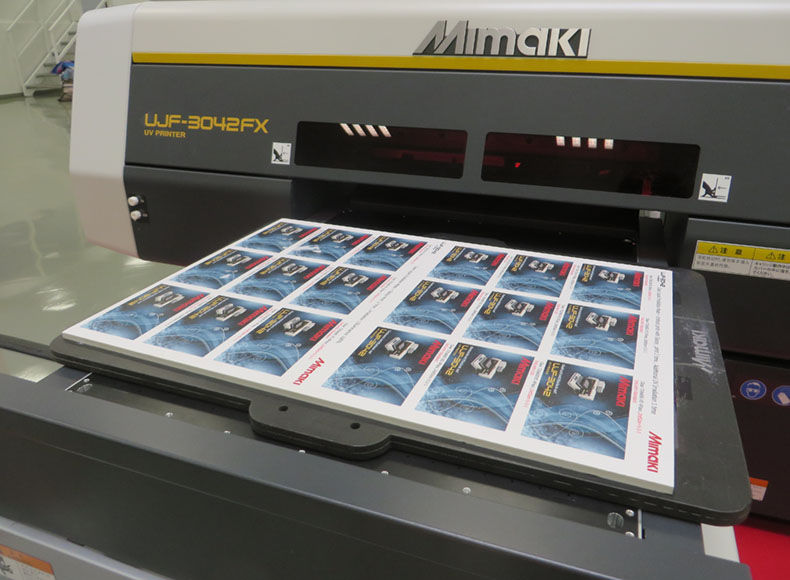The other crisis: What can printers do to tackle climate change and COVID-19?
.jpg?width=750)
Across Europe, measures to contain the pandemic are putting extra pressure on digital printers. Considering the current pandemic, it is quite easy to underestimate another global crisis. The battle against climate change is ongoing but also has a direct impact on the printing industry. Time to get prepared.
Events and restaurants have shut down, and in most countries most shops are closed, as the COVID-19 crisis has digital printer´s customers firmly in its grip. This situation is particularly hard on print shops that focus on POS applications. However, the climate crisis is still something that this industry needs to focus on.
COVID-19 Slashes Turnover of Printing Industry

Caption: The demand for digitally printed POS applications has significantly fallen in 2020. Many printers were forced to cut costs to stay afloat. Photo: S. Angerer
Compared to 2019, sales in the printing industry as a whole have considerably flattened. This still has a profound impact on their suppliers:
- Less demand for consumables
- Reduced interest in investing in machinery
- Service contracts have been changed or terminated
- Textile printing
- Soft Signage
- Individualized interior design
- Personalized gifts and promotional items
- Packaging
Today, it is not quite clear how long the pandemic will last or what its long-term effects will be. However, this is no reason to underestimate or forget about the current climate crisis. Brand owners and governments, amongst others, have created measures to stop global warming. Some of these measures will directly affect the business of digital printers.
Governmental Engagement for Climate Protection

Caption: Digital printers with UV-LED technology consume less electrical power. This reduces printing costs but also helps the environment. Photo: S. Angerer
At the national level, Germany will introduce CO2 pricing for heating and transport as early as 2021.The new German Climate Protection Act of September 2020 also stipulates that greenhouse gas emissions will be significantly reduced by 2030. There will be an annual review as well as additional measures that will be put in place. By 2050, Germany aims to be carbon neutral on a federal level. This means, that printers’ corporate fleets as well as heating of offices and production spaces will become increasingly more expensive in the coming years as a direct result of climate protection laws.
The EU is also pressing for more measures to be introduced in its member states, in order to support the UN SDGs. Since 2015, a main goal is to create a Circular Economy. However, many of today’s wide format printing applications are quite unsuitable for recycling.
This applies in particular, (but not exclusively) to trade shows, store designs, packaging and POS applications, as the finished product is effectively a composite, most often only fit for the waste incinerator or landfill.
Big brands are under pressure from all sides to increase their efforts to help mitigate climate change, as legislators often focus on large corporations, with those company´s sheer size establishing their enormous impact on the environment. At the same time, corporations need to always consider investors as well as customers, keeping in mind to always maintain a favourable brand image.
Environmentally conscious buyers expect that their favourite brands will be sustainably responsible in helping to save the planet. Investment-firms have started to establish sustainability as a key necessity for their funding. As a result, today most corporations publish Environmental Reports. In order to create these, they require reliable numbers, for example on the carbon footprint of printed marketing material.
Climate Crisis Will Keep Digital Printers Busy Much Longer than COVID-19

Caption: Single-type materials are easy to recycle, so digital printers should rethink their products to help the fight against the climate crisis. Photo: S. Angerer
The trend towards sustainability is putting the printing industry under pressure. More and more brands have already started to “de-list” print shops without environmental protection certification. Some corporations even request Environmental Reports from their suppliers. Smaller printers may find this particularly difficult, as there is a vast amount of administrative work to do.
However, many printers and sign makers have already heavily invested in environmental protection in recent years. Frequent measures include:
- Environmental audits (ISO 14001)
- Investments in renewable energy (e.g. solar panels and heat pumps)
- Measures to save energy in buildings and machinery
When an increased focus on environmental protection is communicated appropriately, printers are then able to strengthen their market position. In some cases, it is even possible to charge some additional costs to the customer. With the sharp decline for print products during the pandemic crisis, it is however quite likely that it will prove much more difficult to impose a premium for environmentally friendly products to corporate customers.
To Kill Two Birds with One Stone
“Reduce, reuse, recycle” is a key attitude for a more sustainable use of natural resources. In fact, this slogan could just as well be used as a comprehensive model for the restructure of a digital print shop during COVID-19.
Reduce: Reduce material usage, for example by streamlining the selection of print substrates
Reuse: Use material repeatedly, as many times as possible, e.g. aluminium composite board and display frames.
Recycle: Used material collected can often be disposed of more cheaply.
Therefore, using sustainable materials can save money during the entire production process in a digital print shop. The quality of the product will usually not be affected in any way. This, of course, helps both the printers margins as well as the environment.
However, it is necessary for there to be a comprehensive digitization throughout the whole workflow in order to guarantee an effective just-in-time production. This may sound a little awkward for digital printers, since they tend to view themselves as leaders of digitization in the printing industry.
However, the double blow from COVID-19 and climate change makes it more necessary than ever for digital printers to step up. In order to have a cost and material efficient production that barely effects the environment requires a comprehensive overview and integration of all steps. Starting from when the customer’s orders come in, all the way through warehousing, printing, finishing, quality control, logistics and assembly, returns and then invoicing. This new, wholly-integrated level of digitization in the digital printing industry will go far beyond the production workflows we have been seeing in place for many printers for years.
COVID19 as an Opportunity for Printers
COVID-19 has considerably affected many printers; however it is important for printers to view this as a unique opportunity.
Many printers have postponed their plans for reorganising their business e.g. when introducing a disruptive software during ongoing operations seems too risky. Now is the time to make digital print shops more efficient and environmentally friendly. Comprehensive governmental COVID-19 mitigation programmes like German “KfW Corona Hilfe” may be able to help with the financing. So perhaps, the pandemic really is the historic opportunity for the printing industry to make a significant progress in the fight against climate change.
Topics
Interested in joining our community?
Enquire today about joining your local FESPA Association or FESPA Direct
Recent news

The power of digital design tools in screen printing
James Gatica shares how the combination of traditional screen-printing techniques with cutting-edge digital design tools is revolutionising the way designers conceptualise and produce custom decorative pieces.

Key trends and market shifts on Personalisation and Sportswear with Epson
Debbie McKeegan speaks to Duncan Ferguson, VP of Commercial and Industrial Printing at Epson Europe about the market shifts and current trends around personalisation. Duncan shares the key trend of merging both fashion and sportswear.

